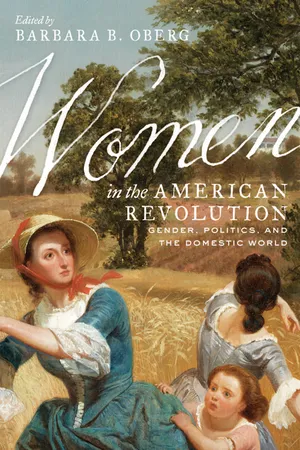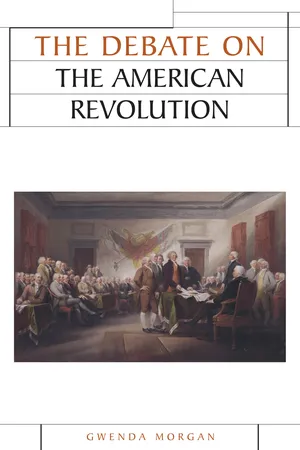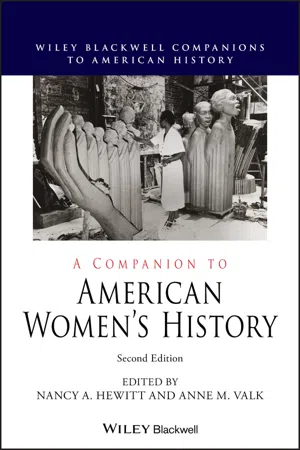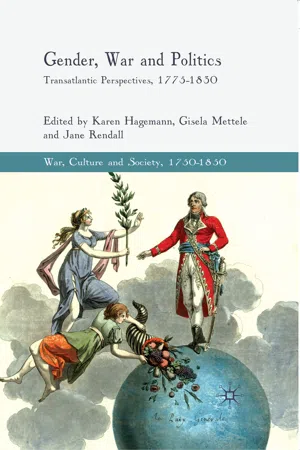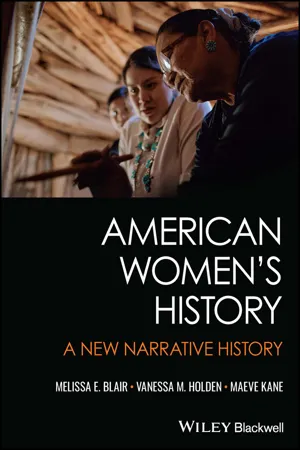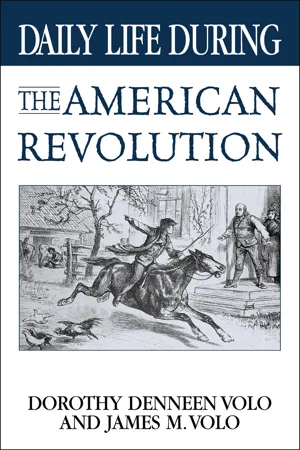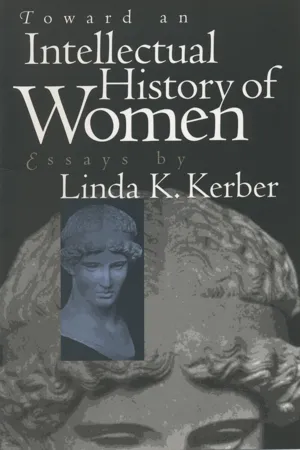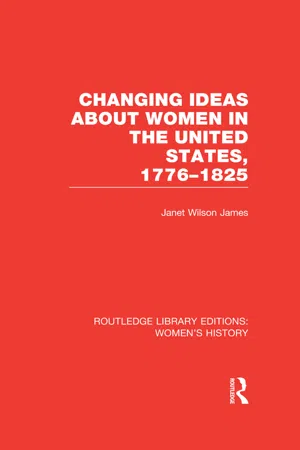History
Women in the American Revolution
Women played a significant but often overlooked role in the American Revolution. They contributed in various ways, such as managing households and businesses, providing support to soldiers, and even participating in combat. Some women also became outspoken political activists and writers, advocating for women's rights and contributing to the revolutionary cause. Their contributions helped shape the outcome of the revolution and laid the groundwork for future advancements in women's rights.
Written by Perlego with AI-assistance
Related key terms
1 of 5
11 Key excerpts on "Women in the American Revolution"
- eBook - ePub
Women in the American Revolution
Gender, Politics, and the Domestic World
- Barbara B. Oberg(Author)
- 2019(Publication Date)
- University of Virginia Press(Publisher)
Introduction Rosemarie ZagarriWhat did the American Revolution mean to—and for—women? Only within the past half-century has this question come to be considered a valid and important topic of scholarly inquiry. Among previous generations of historians, the American Revolution was assumed to be by, for, and about men—usually white men, who were often of elite status. These were, after all, the individuals who led the armies, fought the battles, and gathered in legislative assemblies to create a new government for the country. Changes within the field of history, however, have challenged the conventional narrative. With the development of social history in the 1970s, women’s history in the 1980s, and gender history in the 1990s, scholars and nonscholars alike have come to realize that one cannot fully understand the American Revolution without understanding women’s participation in, and contributions to, the revolutionary movement. Yet not all women supported the revolutionary cause. Like some men, certain women remained loyal to the Crown. In addition, it has become clear that those on the margins of the Revolution, including lower-class white women, enslaved women, free black women, and Native American women, should have a place in accounts of the period. Willingly or not, these groups often found themselves swept up in the revolutionary maelstrom.1Women played an integral role in all phases of the revolutionary process: in the prerevolutionary movement to resist British policies, in the struggles during the War for Independence, and afterward, in efforts to build a new nation. Nonetheless, after decades of scholarship on this topic, there is still no consensus on a critical question: did the Revolution benefit women or actually reinforce traditional gender roles? For white women, much of the attention thus far has been on their political or legal status, which, at least on the surface, did not change much. The doctrine of coverture, which declared women legally subordinate to their husbands or fathers, persisted. Married women could not own property, make contracts, or sue (or be sued) in court. Women did not win the vote (except briefly in New Jersey); nor could they hold public office. They remained legally invisible.2 - eBook - PDF
- Gwenda Morgan(Author)
- 2024(Publication Date)
- Manchester University Press(Publisher)
215 6 ‘A new era in female history’ When Ray Raphael wrote that ‘there were few ladies of leisure in late colonial America’, that ‘most women worked, and worked hard’, and that resistance to British policy and the revolutionary war required them to work even harder, he was expressing a view that would have been unintelligible before the late twentieth century. 1 Yet the role of Women in the American Revolution, unlike that of Native Americans, went largely unrecognized by the revolutionary generation of historians as well as those who came after them. 2 Women were not wholly absent from contem- porary histories but as a subject of serious scholarly inquiry, the history of women ‘is less than four decades old’. 3 Writing in the now classic anthology, Women in the Age of the American Revolution (1989), Linda Kerber (1940–) defined the problem with the revolutionary historians as both conceptual and linguis- tic; they ‘literally lacked a language’ to describe what was going on in front of their very eyes. 4 Mary Beth Norton’s essay in the same volume explored the question of why women remained in the shadows once history developed as a professional discipline. Male historians of the Revolution, it seems, ‘simply ignored the experience of women altogether’, while women writers, lacking the educational opportunities and professional training long open to men, were more interested in the history of the family and broader questions about women’s role in the past. 5 The gender division persisted and only in the last quarter of the twentieth century did the history of women and the history of the Revolution intersect. Finally in 1989, Linda Kerber could write ‘the ingredients – both material and theoretical – for an analysis that recognizes the role of gender in the revolutionary war are now available. We know better than to discount the female expe- rience as inherently marginal or trivial’. 6 The revolutionary generation The discourse of history was masculine. - eBook - ePub
- Nancy A. Hewitt, Anne M. Valk, Nancy A. Hewitt, Anne M. Valk(Authors)
- 2020(Publication Date)
- Wiley-Blackwell(Publisher)
Chapter Five Women and the Long American RevolutionSerena ZabinAs a colonial rebellion that fractured complex relationships between Britain and America, as a war that ended or upended the lives of millions, and as the foundation of a new political nation that made novel claims to the basis of its political authority, the American Revolution was not a single event. Its foundational language of liberty and its assertions of equality have been emphasized by historians over many generations, but those same claims make it easy to dismiss the Revolution as either irrelevant to women or as hypocritical in its aims. The scholarship of the last thirty years, moreover, has made clear that the category of woman is itself nearly meaningless in the eighteenth century. As scholars increasingly focus on the intersections of gender with economic status, age, ethnicity, and race, the question of whether women had a revolution – the focus of several early studies – seems less relevant. This shift was already apparent when Jan E. Lewis analyzed women in the era of the Revolution for the 2002 edition of A Companion to American Women’s History. That change in perspective now dominates the field.In the past two decades, historians have responded to the complex relationship of gender, identity, and revolution in two ways. Some have produced studies, many of them excellent, on particular subsets of eighteenth‐century women’s lives, not all of which even acknowledge the presence of the American Revolution. Conversely, others have attempted to break down the impact of the Revolution or the importance of its various actors by separating out categories of white, black (both free and enslaved), and indigenous women. This second approach has had the unexpected effect of revealing much more about race than about gender. As white men gained increasing political power regardless of social status, so did white women, if more slowly. Changes that the Revolution wrought on the institution of slavery – both its limitations and expansions – affected men and women together. Similarly, the Revolutionary War shattered native homelands and devastated men and women equally, although not in the same way. - eBook - PDF
Gender, War and Politics
Transatlantic Perspectives, 1775–1830
- K. Hagemann, G. Mettele, J. Rendall, K. Hagemann, G. Mettele, J. Rendall(Authors)
- 2010(Publication Date)
- Palgrave Macmillan(Publisher)
While the image of the woman warrior has had the greatest romantic appeal and has served as an icon of revolution- ary change in gender roles, cumulatively the female followers and women at home performed the most service in the War for Independence. They did so within the traditional, socially prescribed realm but also by acting in untraditional ways. Furthermore, the need for both material and ideo- logical support increased public recognition of women’s roles and influ- ence. Whether as combatants or non-combatants, whether participants by choice or chance, as women mobilized, they made this people’s war a revolutionary one. Notes 1. Recent works on this people’s war include: Wayne E. Lee, ‘The American Revolution’, in Daily Lives of Civilians in Wartime Early America: From the Colonial Era to the Civil War , ed. David S. Heidler and Jeanne T. Heidler (Westport, CT, 2007), 31–67, 34–40; Gregory T. Knouff, The Soldiers’ Revolution: Pennsylvanians in Arms and the Forging of Early American Identity (University Park, PA, 2004); Wayne Bodle, The Valley Forge Winter: Civilians and Soldiers in War (University Park, 184 Holly A. Mayer PA, 2002); John Resch, ‘The Revolution as a People’s War’, in War and Society in the American Revolution: Mobilization and Home Fronts, ed. John Resch and Walter Sargent (DeKalb, 2007), 70–102. 2. Karen Hagemann, ‘ “Heroic Virgins” and “Bellicose Amazons”: Armed Women, the Gender Order and the German Public during and after the Anti-Napoleonic Wars’, European History Quarterly 37/4 (2007): 507–527, 508. See also Chapter 9 by Thomas Cardoza in this volume. 3. John Shy delineates a ‘triangularity of the struggle’ in ‘The American Revolution: The Military Conflict Considered as a Revolutionary War’, in Essays on the American Revolution, ed. Stephen G. Kurtz and James H. Hutson (Chapel Hill, 1973), 121–156. 4. Joan R. Gundersen, To Be Useful to the World: Women in Revolutionary America, 1740–1790 (New York, 1996), 149–154. - eBook - PDF
American Women's History
A New Narrative History
- Melissa E. Blair, Vanessa M. Holden, Maeve Kane(Authors)
- 2023(Publication Date)
- Wiley-Blackwell(Publisher)
Conclusion The era of the American Revolution brought upheavals and changes to many women’s lives. Indigenous women guided their nations to secure their communities’ land and sovereignty. Enslaved and free Black women seized opportunities to self-emancipate and secure their freedom before, during, and after the Revolution. Settler, Black, and Indigenous women navigated the violence of war in many roles and participated in political discourse about what women’s roles and the new nation would look like. Gender ideology underlays many of the political and diplomatic conflicts and fears of this period. Although the Revolution was fought for the ideals of liberty and equal- ity, the unequal treatment of white women and both free and enslaved Black people under the law left fundamental questions of the extent of liberty unresolved. Bibliography Berkin, Carol. Revolutionary Mothers: Women in the Struggle for America’s Independence. Vintage, 2006. Brekus, Catherine A. Strangers and Pilgrims: Female Preaching in America, 1740–1845. University of North Carolina Press, 1998. Cleves, Rachel Hope. The Reign of Terror in America: Visions of Violence from Anti-Jacobinism to Antislavery . Cambridge University Press, 2009. Girard, Philippe. “Rebelles with a Cause: Women in the Haitian War of Independence, 1802–04.” Gender & History 21, no. 1 (2009): 60–85. https://doi.org/10.1111/j.1468- - 0424.2009.01535.x. Haulman, Kate. The Politics of Fashion in Eighteenth-Century America. Gender and American Culture. University of North Carolina Press, 2011. Kane, Maeve. Shirts Powdered Red: Haudenosaunee Gender, Trade, and Exchange Across Three Centuries. Cornell University Press, 2023. Kelley, Mary. Learning to Stand and Speak: Women, Education, and Public Life in America’s Republic. University of North Carolina Press, 2008. Kerber, Linda K. Women of the Republic: Intellect and Ideology in Revolutionary America. University of North Carolina Press, 1980. Klepp, Susan E. - Christine Bolt(Author)
- 2014(Publication Date)
- Routledge(Publisher)
In the basic contours of their lives, American and British women were essentially alike: excluded from politics, accorded an inferior education, seen as possessing unique feminine traits, leading domestic lives, uncomfortably placed if single, and taking pleasure in their children, female friends and religion. There was no distant golden age for women in either country, though economic freedoms had been greater and political activities a little less circumscribed in the early modern period than they were in the mid-eighteenth century. Yet, as we have seen, by then there were the first signs of changing attitudes and expectations among women regarding marriage and children, and they had established a position in the churches, especially the Protestant denominations, which indicated both the actual and potential power of female moral energy. New forces of change and reaction in politics, ideas, religion and the economy in the last quarter of the eighteenth century stirred up areas of women’s life where there was formerly no flux, accelerated movement in areas where alteration was already under way, and raised expectations which could not always be realised. In so doing, they simultaneously prepared the way for woman as feminist and reformer, and for the Victorian notion of the ‘angel in the house’. The experience of the Revolution also helped to implant in American women a sense that they enjoyed special advantages and responsibilities: a belief which, however much nineteenth-century feminists may have exaggerated the blessings of their own past, was to become an important feature of their campaign.II. Forces for change
(i) The American Revolution
The American Revolution, as Kerber, Norton and Countryman point out, had a profoundly politicising effect on the female population of the colonies. Among women and colonial leaders alike, it forced an unusual awareness of women’s importance as consumers and potential boycotters of British imports, producers of vital goods and general managers of the household economy. As the conflict with Britain affected their daily lives, took away their husbands and divided their families, women assumed men’s jobs, debated political issues and became less apologetic about doing so than they had once been. They participated in crowd actions as a vital part of their communities, petitioned Revolutionary governments and local committees of safety in pursuit of their interests as wives and mothers, and – in Pennsylvania, New Jersey and Maryland – raised money to help the war effort.76These new activities brought women no direct political return. Averting political tyranny and ensuring the survival of the young republic were more important objectives than sexual or racial equality for its male politicians and political theorists. Countryman has shown that only groups which ‘had established their political identity in the Revolution’ were subsequently ‘in a position to struggle for their concerns’; and women, like non-whites, had not effectively done so.77 Such ventures as boycotts and the homespun production drive unfortunately looked like a mere extension of traditional female undertakings,78 and women’s support was freely given and promptly accepted without apparently provoking any sense that a reward might be appropriate.79 As a result, women had difficulty in obtaining war widows’ pensions after hostilities ended, and they were enfranchised only by New Jersey, which in 1776 gave the vote to all its free adult inhabitants. Although the Revolution was not embarked upon to create a democracy, it did encourage a further democratisation of the suffrage; the meagre consequences of this process for women are therefore particularly disappointing. By 1807, blacks and women had been disenfranchised even in New Jersey, on the grounds that they were the elements most liable to manipulation in the state’s corrupt political system.80- eBook - PDF
- Dorothy Volo, James M. Volo(Authors)
- 2003(Publication Date)
- Greenwood(Publisher)
13 Women at War We may destroy all the men in America, and we shall still have all we can do to defeat the women. —Charles Lord Cornwallis POLITICAL AWARENESS The brave deeds and tremendous hardships of the soldiers during the Revolution have long been recognized and saluted. Equal accolades have often eluded the sacrifices and efforts of American women during this same period. In the wake of the Townshend Acts and the Tea Act, boy- cott organizers turned to the housewives of America for support. There was little necessity to convince the women of the contributions they could make. The ladies quickly realized that their economic decisions had important political implications. They rallied to the cause, making what contributions they could in light of their social class, personal re- sources, and physical abilities. As disputes between the colonies and the British empire moved from impassioned rhetoric to armed conflict, women were called upon to make even greater sacrifices. When men marched away to defend their homes, their wives and daughters took up the men's labors and shoul- dered them along with the already burdensome obligations of eighteenth-century homemaking. Quietly, women stepped in to fill the void. They worked on the farm or in the shop, fed and clothed the chil- 230 Daily Life During the American Revolution dren, kept the home intact, and supplied the armies with the necessities of life. The spirit of the patriot woman was an invaluable factor in the struggle for independence. The social climate of pre-Revolutionary America severely limited women's roles and generally excluded them from the political process. Yet in the decade between the Stamp Act and the Declaration of Inde- pendence, women became more politically aware. Some men among the patriot radicals believed that it was essential for women to become ac- tively involved in political expression if the economic boycotts set in place by the Continental Association were to be successful. - eBook - PDF
- Nancy F. Cott(Author)
- 2013(Publication Date)
- De Gruyter Saur(Publisher)
WOMEN AND WAR 3 WOMEN IN T H E A M E R I C A N R E V O L U T I O N E L I Z A B E T H C O M E T T I W AR was very real to the women of the Revolutionary period. Along the extended frontier there hung a per-petual threat of Indian incursions with their attendant acts of savagery. On the coast and by navigable rivers the British fleet and army kept the inhabitants in an intermittent state of alarm. In the interior sporadic fighting and foraging raids left their victims shaken and impoverished. Yet with the exception of those whom the exigencies of war forced to become refugees, women generally remained at home ministering to the needs of their households, assuming their absent husbands' respon-sibilities, meeting as best they could the inevitable wartime scarcities, taking over jobs compatible with their physical lim-itations and conventions, and longing always for the return of their men and for peace. As if loneliness and sorrow were not enough, war brought privation and destitution to many wives and widows of men in the military service. Even before the continental currency started on its disastrous toboggan slide, soldiers' pay had not been uniform, prompt, or sufficient, despite various bounties offered to encourage enlistments. As there was no general pro-vision for allotments to dependents of fighting men, the latter were often forced to see their loved ones become objects of local charity. Neither were widows and orphans of fighting men adequately or uniformly pensioned, with the result that many of them had to petition the government for relief. - eBook - ePub
Toward an Intellectual History of Women
Essays By Linda K. Kerber
- Linda K. Kerber(Author)
- 2017(Publication Date)
- The University of North Carolina Press(Publisher)
Rosenkrantz and Guildenstern Are Dead: a world that has been turned inside out so that we can pay attention to voices that were present in the original telling but overpowered by the narrator’s choice of central characters.There is much merit to thinking of the era as an “age of the democratic revolution,” and to melding the French and American upheavals into a single set of shared events on a large scale. Lafayette’s career alone may furnish all the proof we need of the merits of that approach. But there were also enormous differences between the political cultures of the two revolutions, a difference that is underscored by the sharp differences in women’s behavior. French women were early to claim their political tongues, beginning with the cahiers of the flower sellers of Paris and proceeding through Olympe de Gouges’ ”Declaration of the Rights of Woman” and the activities of the Society of Revolutionary Republican Women.2 For these collective activities we have no direct counterparts in America. When Rachel Wells petitioned the Continental Congress, she petitioned alone.Indeed, virtually the only mechanism the American republic made available to Rachel Wells was the traditional mechanism of the individual petition, which forces deference and subservience on the claimant. The music of her words is in the counterpoint: there is the tone of the forceful demand (“Now gentelmen is this Liberty”) in which she addresses her readers as an equal; against it rings the tone of the mendicant (“God has spread a plentifull tabel for us & you gentelmen are ye Carvers”). Reading her petition, we learn something about her social status (poor), her role during the revolutionary war (contributor and supporter), and finally her hesitant articulation of the meaning and significance of that experience. - Janet Wilson James(Author)
- 2018(Publication Date)
- Routledge(Publisher)
The closely related idea of submis-sion also came under attack. It was no accident that the term woman's rights was born in the revolutionary era. To women's actual lives the War of Independence brought the disruption characteristic of all wars -- the separations, the inflation, the shortages — but it did not alter popular ideas about women's place. Standards of behavior were slightly relaxed; journalists previously much given to incul-cating the importance of retiring modesty now applauded the young ladies who formed associations to refuse the addresses of any but patriot suitors, even printing their names in the papers along with spirited letters from wives so stirred by America's wrongs that they longed to take up sword and join their husbands in the field .1 Lower-class women actually did follow husbands or lovers to the army, where they formed the disorderly band of camp-followers which was one of Washington's headaches. Some of these managed to be of service as nurses in the field hospitals, however, and a few Molly Pitchers and Deborah Sampsons actually bore arms. But ladies confined their efforts to collecting money, food, and clothing for the 1 Julia Cherry Spruill, Women's Life and Work in the Southern Colonies (Chapel Hill,1335),' 3^5. 67 soldiers, with great bustle and publicity which elicited jeers from the London papers and jokes from their indulgent menfolk. A group of Philadelphia dames who had raised a sum for the Pennsylvania forces, however, showed a sense of propriety by sending with the money a note to General Washington asking him to use it as he thought best, since they knew nothing of affairs of State.” The average woman, of course, served her country in the traditional domestic sphere, by putting social pressure on neighbors of wavering loyalty, boycotting British manufactures and buying American, and keeping her home 2 going for some ten years in a badly dislocated economy.- eBook - ePub
A War of Ideas
British Attitudes to the Wars Against Revolutionary France, 1792–1802
- Emma Vincent Macleod(Author)
- 2019(Publication Date)
- Taylor & Francis(Publisher)
Yet the impositions of this war upon the British people in terms of military participation, vulnerability to a French invasion and liability for providing the material resources required to finance the war effort brought the conflict directly into the lives of most British women as well as men. In terms of direct military involvement, however, women could at most be spectators, not actors, in the drama. Eighteenth-century warfare was a fundamentally male-dominated phenomenon. As necessary spectators, therefore, their views hold interest in the context of the war debate. What did women think about the conflict, and how did they express their opinions? Moreover, how does their involvement in the war debate fit into the historiographical model of 'separate spheres' of influence and activity for men and women in the 1790s?The difficulties of attempting to assess the significance of the written attitudes of British women to the wars against revolutionary France are largely concerned with lack of evidence. Those women who left detailed written records of their opinions on the conflict were usually exceptional people as well as unusual women for their time, and they are few in number. Furthermore, men wrote much of the literature directed at women. The Lady's Magazine and other periodicals for women were edited by men and mostly written by men; and, while several pamphlets were signed by 'an Englishwoman' or 'Britannia', the text suggests that they were written by men. For these reasons, the following sections rely mostly on texts whose authorships are reasonably certain.Yet the question of female views on the war is important enough, though generally neglected, to be considered seriously on the basis of what evidence there is. Their opinions were naturally often very similar to those of men, but it is arguable that, whatever part of the social or political spectrum they represented, women consistently emphasized certain issues and concerns. Moreover, not only were they trying to answer the questions posed also for men by the conflict but, in a war which had a direct impact on a very wide cross-section of society over such a long period of time, they also struggled with the question of their own role in a society at war. This chapter examines women's contributions to Britain's pamphlet debate on the conflict, as well as journals and letters written by women, in order to gain insight into women's views on the war. In doing so, it also tries to shed light on the ways in which they conceptualized desirable female behaviour during the war. It ends by examining men's attitudes towards women's participation in the conflict and in the debates surrounding it.
Index pages curate the most relevant extracts from our library of academic textbooks. They’ve been created using an in-house natural language model (NLM), each adding context and meaning to key research topics.
